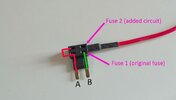Nigel
Well-Known Member
- Joined
- Jul 7, 2014
- Messages
- 17,310
- Reaction score
- 9,059
- Location
- Wales
- Country
- United Kingdom
- Dash Cam
- Gitup F1+G3ꞈꞈꞈꞈꞈ Viofo A229ꞈꞈꞈꞈꞈ Blueskysea B4K
That is a neat solution to adding multiple devices to your accessory circuit, looks a decent device to me.Anyway, he suggested to use one of these. If you don't want to click the link then the listing is basically "6 Ways 12V -32V Blade Fuse Box & Distribution Bar Bus Boat Car Kit Marine Holder".
Fix it in next to the fuse box using some tie wraps.
I was actually thinking of a multiway "cigarette lighter" socket, but this is neater and will take up a lot less space.
The issue with the 7.5A fuses is that all the circuits will be built with maybe 10% safety margin, so the more powerful circuits allow you to take more power before you exceed the safety margin, or if you connect the fuse tap the way around I suggest then the bigger fuses allow you to take more power before you blow the fuse. If you used a circuit with a 1A fuse then you would be doubling or tripling the load, which would not be good.Though I still don't get why the 7.5A fuses should be avoided as you said earlier - things like the dashcam should only be using about 1A total. So that'd be 6.5A left? Or is that not how it works? And I don't mean that in a sarcastic manner - that should just illustrate how little I know about electronics that's all so some of my questions will seem stupid.
So as 2 of my devices are dash cams so that'd be 2x 1A each. The other device is only a phone charger.
If you have a 7.5A fuse that you know is not actually being used then it is fine to use that, or if you know that only 2A of it is used then it is fine to use it with an extra 2A added, but if 7A is being used by something and you add another 2A of load then there is a safety issue.
The advice not to use 7.5A fuses is only because that reduces the risk of unexpected problems.
So in your case you have 2x 1A dashcams, plus a 4A phone charger, so you need a fuse with 2x1+4 = 6A spare capacity. In other words the car equipment using that fuse must not take more than 1.5A.
In reality, your dashcams are going to take more like 0.5A each and your phone charger 1.5A, so you really need a fuse with 2.5A spare capacity.Although having read on it says:
If you can make sense of that?
So are we talking about 4A? 3A? 2A? or 2.4A?
I'd be using the USB-C PD slot if that makes a difference?
(You are measuring your dashcams at 5V, and your car is at 12V+, so you can divide your dashcam Amp figures by 12/5, and your phone charger, if you are only using the PD output, it will only be outputting 2A at 9V at most, which is 1.4A, plus add 0.1A for inefficiencies. The 4A claim will be very pessimistic and only occur if you are using all outputs at minimum battery voltage.)
Those Anker chargers are good, I've got a similar PD one.

